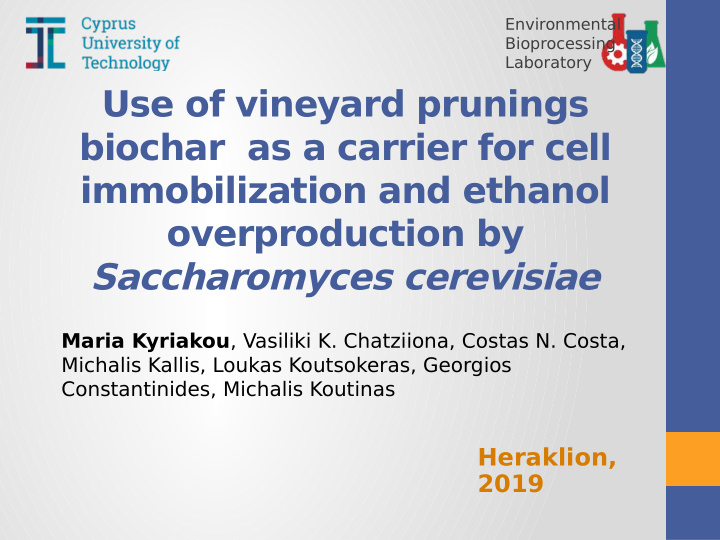



Environmental Bioprocessing Laboratory Use of vineyard prunings biochar as a carrier for cell immobilization and ethanol overproduction by Saccharomyces cerevisiae Maria Kyriakou , Vasiliki K. Chatziiona, Costas N. Costa, Michalis Kallis, Loukas Koutsokeras, Georgios Constantinides, Michalis Koutinas Heraklion, 2019
T echnology of bioethanol • Biodiesel and bioalcohols constitute the most important biofuels • Highlights the need to identify alternative feedstocks for sustainable manufacturing • Current limitations of bioethanol technology: • Cooling and distillation cost • Lack of rigid carriers for recirculation of yeasts
Biochar as a yeast immobilization carrier • Substrate and product inhibition • Immobilized biocatalysts • Alginate gel beads have poor mechanical properties • Biochar • Environmental management and soil amendment • Immobilization of heavy metals • Enhance methane production in anaerobic digestion • Promotes interspecies electron transfer • Improves cell activity and growth • Assists bufgering capacity and nutrient adsorption into their surface
Aim of the study • Evaluate the use of biochar as a renewable and low-cost support material for whole-cell immobilization • Enhance bioethanol production emphasizing Saccharomyc the importance of es employing elevated cerevisiae temperatures in order to Kluyveromyc reduce the energy es marxianus demand of manufacturing. Pichia kudriavzevii
Pyrolysis for biochar production Non- biologi cal char Sewag e sludge Pyroly sis Olive Material kernel Bioch 250 and characterizati s 500 o C ar Vineyar on d prunin Immobilizatio gs n Sea grass Bioethanol fermentation s
Material characterization Energy Dispersive X-Ray analysis Elemental analysis EDX NaCl Si X-Ray Diffraction analysis KCl Phase identification of crystalline materials XRD CaCO 3 Brunauer–Emmett–Teller method Determination of specific surface area BET Scanning Electron Microscopy Porosity and Structure characteristics SEM
Scanning electron microscopy 250 o 500 o C C Olive kernels 50 μm 50 μm Sea grass 50 μm 50 μm Vineya rd SEM prunin 50 μm 50 μm gs
Scanning electron microscopy 250 o 500 o C C Sewage sludge 50 μm 50 μm Non- biological char 50 μm SEM
Surface area and elemental composition EDX BET
S. cerevisiae immobilized E th a n o l C o n c . [g L -1 ] cells 1 st batch 2 nd batch 80 Temperature 60 37 o C 40 20 0 0 5 10 15 20 25 30 35 Time [h] Vineyard prunings biochar 7.2 g L -1 h -1 Non-biological char 6.0 g L -1 h -1 Sea grass biochar 4.8 g L -1 h -1 Free cells 5.3 g L -1 h -1 S. cerevisiae immobilized on vineyard prunings
K. marxianus immobilized E th a n o l C o n c . [g L -1 ] cells 1 st batch 2 nd batch 80 Temperature 60 42 o C 40 20 0 0 5 10 15 20 25 30 35 Time [h] Vineyard prunings biochar 7.3 g L -1 h -1 Non-biological char 5.6 g L -1 h - 1 Sea grass biochar 4.3 g L -1 h -1 Free cells 4.9g L -1 h -1 S. cerevisiae immobilized on vineyard prunings
P . kudriavzevii E th a n o l C o n c . [g L -1 ] immobilized cells 1 st batch 2 nd batch 80 Temperature 60 42 o C 40 20 0 0 5 10 15 20 25 30 35 Time [h] Vineyard prunings biochar Non-biological char Sea grass biochar Free cells S. cerevisiae immobilized on vineyard prunings
Bioethanol production from immobilized S. cerevisiae Ethanol conc. Ethanol prod. Specific surface area Feedstock Carrier (g L -1 ) (g L -1 h -1 ) (m 2 g -1 ) Alginate-based MCM-41 mesoporous Sugar molasses 78.6 6.55 - zeolite composite Cane molasses Bacterial cellulose-alginate sponge 92 1.92 - Glucose and sucrose Sorghum bagasse 92.7 5.72 3.0-5.0 [54] Sugarcane bagasse Sugarcane bagasse 15.4 0.43 3.0-12.7 [55] Blackstrap molasses Thin-shell silk cocoon 80.6 1.85 - Sugar beet thick juice Sugar beet pulp 52.3 1.09 3.0-16.5 [55] Sorghum juice Sweet sorghum stalks 98.5 1.37 3.0-5.0 [54] Mahula flower Calcium alginate 25.8 0.27 - Corn meal Calcium alginate 88.9 2.34 - Wheat straw Calcium alginate 37.1 0.38 - Glucose Mineral Kissiris 48 3.06 2.2 [62] Molasses Orange peel 58.9 4.17 0.4 [63] Orange peel waste Non- biological char 60 6.0 73.0 hydrolysate Orange peel waste Vineyard prunings biochar 72 7.2 41.7 hydrolysate Orange peel waste Non- biological char 56 5.6 73.0 hydrolysate Orange peel waste Vineyard prunings biochar 73 7.3 41.7 hydrolysate
Application of other materials • High specifjc surface area • High concentration of micropores Carbon foam Pistachi os Pyroly Peanu Immobilizati Biocha sis ts on r 500 o C Bioethanol Corks fermentation s
Scanning electron microscopy Peanuts Corks biochar biochar 50 μm 50 μm 50 μm 50 μm Pistachios Carbon foam biochar 50 μm 50 μm 300 μm 100 μm 50 μm 50 μm x x 500 SEM 1500
S. cerevisiae immobilized E th a n o l C o n c . [g L -1 ] cells 2 nd batch 3 rd batch 1 st batch 80 70 60 50 40 30 20 10 0 0 10 20 30 40 50 Time [h] Pistachios biochar 7.8 g L -1 h -1 Peanuts biochar 5.4 g L -1 h Temperatur -1 e Corks biochar 5.7 g L -1 h -1 37 o C Carbon foam 1.5 g L -1 h -1 Free cells 4.0 g L -1 h -1
Conclusions • Pyrolysis conditions strongly afgect: • Morphology • Physicochemical properties Pyrolysis temperature specifjc surface area and porosity S. High ethanol 37 cerevisiae Vineyard concentration o C prunings K. biochar 42 marxianus o C S. Pistachios Improvement 37 cerevisiae biochar ethanol productivity o C
Environmental Bioprocessing Laboratory
Recommend
More recommend